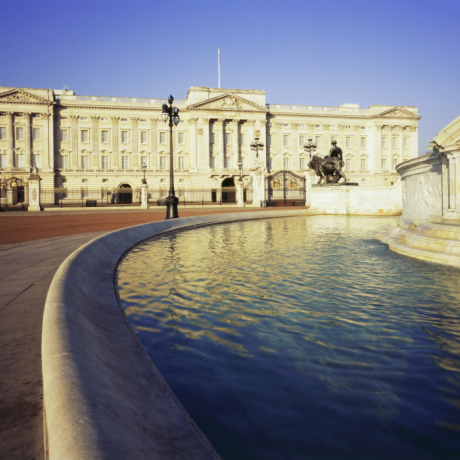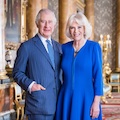- Overview
- Sources of funding
- How the finances are used
- Financial arrangements of The Prince of Wales
- Taxation
- The Crown Estate
- Civil List and Grant-in-Aid
- Financial Glossary
Overview
The Monarchy has sometimes been described as an expensive institution, with Royal finances shrouded in confusion and secrecy. In reality, the Royal Household is committed to ensuring that public money is spent as wisely and efficiently as possible, and to making Royal finances as transparent and comprehensible as possible.
Each year the Royal Household publishes a summary of Head of State expenditure, together with a full report on Royal public finances. These reports can be downloaded from the Media Centre.
This section provides an outline of how the work of the Monarchy is funded. It includes information on Head of State expenditure, together with information about other aspects of Royal finances.
On 1 April 2012 the arrangements for the funding of The Queen’s Official Duties changed. The new system of funding, referred to as the ‘Sovereign Grant’, replaces the Civil List and the three Grants-in-Aid (for Royal Travel, Communications and Information, and the Maintenance of the Royal Palaces) with a single, consolidated annual grant.
The Sovereign Grant is designed to be a more permanent arrangement than the old Civil List system, which was reign-specific. Funding for the Sovereign Grant comes from a percentage of the profits of the Crown Estate revenue (initially set at 15%). The grant will be reviewed every five years by the Royal Trustees (the Prime Minister, the Chancellor of the Exchequer and the Keeper of the Privy Purse), and annual financial accounts will continue to be prepared and published by the Keeper of the Privy Purse.
The new system provides for the Royal Household to be subject to the same audit scrutiny as other government expenditure, via the National Audit Office and the Public Accounts Committee.
If you would like to find out more, please visit the Treasury’s website.
Sources of funding
There are three sources of funding for The Queen, or officials of the Royal Household acting on His Majesty’s behalf, in both a public and private capacity. These are: the Sovereign Grant, the Privy Purse and The King’s personal wealth and income.
The Sovereign Grant
This is the amount of money provided by Government to the Royal Household in support of The King’s official duties, including the maintenance of the Occupied Royal Palaces: Buckingham Palace, St James’s Palace, Clarence House, Marlborough House Mews, the residential and office areas of Kensington Palace, Windsor Castle and the buildings in the Home and Great Parks at Windsor, and Hampton Court Mews and Paddocks.
The Sovereign Grant is provided by HM Treasury and consolidates the funding previously provided through the Civil List and the Property Services, Communications and Information and Royal Travel Grants-in-aid. HM Treasury is responsible for monitoring the application of the Sovereign Grant in accordance with the Memorandum of Understanding between HM Treasury and the Royal Household.
The first Annual Report covering the new arrangements under the Sovereign Grant was for the year to 31 March 2013 and was published in June 2013. The most recent Annual Report can be found on our Media Centre.
Privy Purse and Duchy of Lancaster
This is a historical term used to describe income from the Duchy of Lancaster, which is used to meet both official and private expenditure by The Queen.
The Duchy of Lancaster is a portfolio of land, property and assets held in trust for the Sovereign in his/her role as Sovereign. It is administered separately from the Crown Estates.
Its main purpose is to provide an independent source of income, and is used mainly to pay for official expenditure not met by the Sovereign Grant (primarily to meet expenses incurred by other members of the Royal Family).
The King's personal wealth and income
The King’s personal income, derived from his personal investment portfolio and private estates, is used to meet his private expenses.
The King owns the Balmoral and Sandringham Estates, which were both inherited from his mother.
Estimates of The King’s wealth often mistakenly include items which are held by him as Sovereign on behalf of the nation and are not his private property. These include the official Royal residences, the majority of art treasures from the Royal Collection and the Crown Jewels. The King cannot sell these – they must pass to his successor as Sovereign.
How the finances are used
The various official sources of funding detailed in this section are used entirely to support The King’s work as Head of State.
This means that the money goes towards a number of resources which enable His Majesty to carry out his official duties. These include: Royal travel for official engagements in the UK and overseas; the maintenance of Royal residencies which are used for formal entertaining and ceremonial events; funding for the work of The Queen which supports and complements that of The King and salaries for employees of the Royal Household who support and administrate the work of His Majesty as Head of State.
Financial arrangements of The Prince of Wales
The Prince of Wales's life and work are funded predominantly by the Duchy of Cornwall. The Prince of Wales does not receive money from the Sovereign Grant, but it is used, in part, to support His Royal Highness's official activities.
The Duchy of Cornwall is one of the largest and oldest estates in Britain. It includes around 54,521 hectares in 23 counties, mostly in the South West of England.
The Duchy estate was created in 1337 by Edward III for his son and heir, Prince Edward, and its primary function was to provide him and future Princes of Wales with an income from its assets. The Prince became the 24th Duke of Cornwall on The King's accession in 2023.
It was traditional for many centuries for families with landed estates to settle the land and other assets in trust, so that each generation could live off the income but was unable to sell the assets.
This was done to ensure that the estate, and the income which it provided, survived from generation to generation. The same principle was applied to the Duchy of Cornwall.
Under the 1337 charter, as confirmed by subsequent legislation, The Prince of Wales does not own the Duchy's capital assets, and is not entitled to the proceeds or profit on their sale, and only receives the annual income which they generate (which is voluntarily subject to income tax).
The Duchy's founding charter included the gift of estates spread throughout England. It also stated that the Duchy should be in the stewardship of the Heir Apparent, to provide the Heir with an income independent of the Sovereign or the State.
After 670 years, the Duchy's land holdings have become more diversified, but the Duchy is still predominantly an agricultural estate.
Because of the importance of the beneficiary, the Duchy's 'trust provisions' have over the years, been set out in legislation, with the financial security of the Duchy overseen by HM Treasury.
His Royal Highness receives the annual net surplus of the Duchy of Cornwall and chooses to use a large proportion of the income to meet the cost of his public and charitable work.
The Duchy is tax exempt, but The Prince of Wales voluntarily pays income tax at the highest rate on his taxable income from it.
He is in effect a trustee, and is not entitled to the proceeds of disposals of assets. The Prince must pass on the estate intact, so that it continues to provide an income from its assets for future Dukes of Cornwall.
The landed estate includes agricultural, commercial and residential property. The Duchy also has a financial investment portfolio. It is run on a commercial basis, as prescribed by the parliamentary legislation which governs its activities.
Taxation
The King pays tax.
In 1992, Queen Elizabeth II volunteered to pay income tax and capital gains tax, and since 1993 the Monarch's personal income has been taxable as for any other taxpayer.
The King is subject to Value Added Tax and pays local rates on a voluntary basis.
The Crown Estate
The Crown Estate as a whole dates back from the time of the Norman Conquest.
In 1760, George III reached an agreement with the Government over the Estate. The Crown Lands would be managed on behalf of the Government and the surplus revenue would go to the Treasury. In return, the King would receive a fixed annual payment, which was called the Civil List. With effect from 1 April 2012, the Civil List was incorporated into a new system of funding referred to as the Sovereign Grant.
The Crown Estate is not the personal property of the Monarch. It cannot be sold by the Monarch, nor do any profits from it go to the Sovereign.
The Crown Estate is managed by an independent organisation, headed by a Board, and any profit from the Estate is paid every year to the Treasury for the benefit of all UK taxpayers. The Treasury is effectively the principle Government stakeholder and is kept informed of the estate’s overall business plans and strategies.
The Estates portfolio has a value of over £7.3 billion, from beef farms in the north of Scotland to Portland stone mining in Dorset. Windsor Great Park is the only Royal Park managed by the Crown Estate. All other parks are administered by the Royal Parks Agency.
For more information visit the Crown Estate's website.
Civil List and Grant-in-Aid
On 1 April 2012 the arrangements for the funding of The King’s Official Duties changed. The new system of funding, referred to as the ‘Sovereign Grant’, replaced the Civil List and the three Grants-in-Aid (for Royal Travel, Communications and Information, and the Maintenance of the Royal Palaces) with a single, consolidated annual grant.
The Sovereign Grant is designed to be a more permanent arrangement than the old Civil List system, which was reign-specific.
The Civil List
Up until 31 March 2012, the Civil List was the amount of money provided by the Government to meet the official expenses of The Queen’s Household, so that Queen Elizabeth II could carry out her role as Head of State and Head of the Commonwealth.
In 1760, George III reached an agreement with the Government over the Crown Estate. The Crown Lands would be managed on behalf of the Government and the surplus revenue would go to the Treasury. In return, the King would receive a fixed annual payment, which until 31 March 2012 was called the Civil List.
About 70 per cent of the Civil List expenditure went on staff salaries. It also contributed towards meeting the costs of official functions such as garden parties, receptions and official entertainment during State Visits. The Queen entertains almost 50,000 people each year.
The Royal Household strives to be open and transparent, and details of expenditure are published in an Annual Summary and Annual Report.
On 2 July 2012 the final report by the Royal Trustees on Civil List expenditure and funding was released.
From 1 April 2012 the funding provided under the Civil List arrangements was consolidated within the Sovereign Grant.
Grant-in-Aid
Each year the Royal Family carries out almost 3,000 official engagements around the United Kingdom and overseas.
Up until 31 March 2012, the Royal Household received annual funding to meet the costs of official travel through the Department for Transport.
Up until 31 March 2012, a separate grant was voted by Parliament each year, through the Department of Culture, Media and Sport, to cover the upkeep of the Royal residencies. These are: Buckingham Palace, St James’s Palace, Clarence House, Marlborough House Mews, the residential and office areas of Kensington Palace, Windsor Castle and the buildings in the Home and Great Parks at Windsor, and Hampton Court Mews and Paddocks. The money was used to meet the cost of maintenance and some utilities.
From 1 April 2012 the Grant-in-Aid provided through the Department for Transport and Department for Culture, Media and Sport was consolidated within the Sovereign Grant provided through HM Treasury.
Financial Glossary
A glossary of terms relating to Royal Finances.
Civil List – The amount of money, a fixed annual payment, provided by Parliament to meet the official expenses of The King’s Household; source of funding up until 31 March 2012.
Crown Estate – Land managed on behalf of the Government. It is not the personal property of the Monarch and His Majesty receives no monies from it.
Duchy of Cornwall – Portfolio of land, property and assets held in trust for The Prince of Wales as heir to the throne.
Duchy of Lancaster – Portfolio of land, property and assets held in trust for the Sovereign in his/her role as Sovereign.
Grant-in-Aid – Funds from the Department of Culture, Media and Sport to meet maintenance of the official Royal Residencies cost and Communications and Information, and funds from the Department of Transport to meet Royal travel costs; source of funding up until 31 March 2012.
Keeper of the Privy Purse – Holds overall responsibility for the management of the Sovereign’s financial affairs.
Privy Purse – Private finances and estates of the Sovereign.
Sovereign Grant – Funds from HM Treasury in support of The King’s Official duties, including the maintenance of the Occupied Royal Palaces, which consolidates the funding provided prior to 1 April 2012 under the Civil List and Grants-in-Aid.



